
Orlandersmith
and others entice audiences with dark characters
and playful sexuality.
An Evening with Dael Orlandersmith
April 10
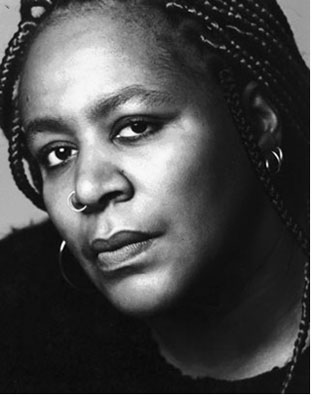 Dael
Orlandersmith has never been to The Andy Warhol Museum,
but as a New Yorker who shared Warhol’s stomping
grounds, this poet, actor, and playwright can riff
on Warhol and his activities with authority. Listeners
are simply expected to hang on as she roller-coasters
through occasionally esoteric references to Warhol’s
outré associates, his dichotomous personality
(“I was always dying to see him without the wig”),
Velvet Underground song lyrics, and other aspects of
his world. Dael
Orlandersmith has never been to The Andy Warhol Museum,
but as a New Yorker who shared Warhol’s stomping
grounds, this poet, actor, and playwright can riff
on Warhol and his activities with authority. Listeners
are simply expected to hang on as she roller-coasters
through occasionally esoteric references to Warhol’s
outré associates, his dichotomous personality
(“I was always dying to see him without the wig”),
Velvet Underground song lyrics, and other aspects of
his world.
Orlandersmith might revisit these subjects
when she appears at The Warhol on April 10 as part
of its Off
the Wall series. However, she definitely plans to
invoke a Holocaust victim and an Italian man, among
other
personas.
“What I tend to do is mix poetry with characters,” she
says. “My characters are kind of fringe people
of all races and ethnic backgrounds. That’s
what interests me.”
That unique mix of poetry and personas turned Orlandersmith
into a Pulitzer Prize finalist and Drama Desk Award
nominee for her 2002 play, Yellowman. She also
earned a Drama Desk acting nod for her role in
the play,
which scrutinizes the internal racism that exists
in black
America.
The tale itself is dark, Orlandersmith
says. In a mock basement-low voice, she reveals
that her
next
play,
now being written, also will be “very dark.” She
likes darkness, depth. She likes rawness.
“I hate when people talk about, ‘Well,
you have to give an audience hope.’…We
have to give ourselves permission to realize that it’s
not always a happy ending,” she says. “And
just because someone doesn’t end it that
way doesn’t mean they’re doing
gratuitous work. I can tell when somebody’s
trying to shock me versus someone who’s
trying to tell me a story because that is the
way it is.”
For the record, Orlandersmith
more or less hung out with Warhol, but she
never wanted
to be part
of his
particular scene — or anyone else’s.
She says she’s not a joiner. She believes
conforming to the confines of any group occurs
at the expense
of one’s individualism. Like all the
best writers and actors, Orlandersmith prefers
to be an observer
of the human condition—in all its up,
down, and turned-around permutations.
Richard Maxwell & the New
York City Players
Showcase
March 6 and 7
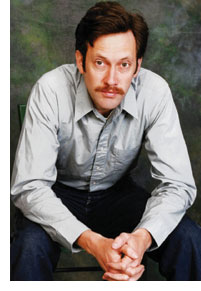 March 6 and 7, Off the Wall moves inside the walls
of a guest room in Downtown Pittsburgh’s Hilton
Hotel, where the New York City Players will perform
Richard Maxwell’s play, Showcase. March 6 and 7, Off the Wall moves inside the walls
of a guest room in Downtown Pittsburgh’s Hilton
Hotel, where the New York City Players will perform
Richard Maxwell’s play, Showcase.
Maxwell, whose
work is characterized by a minimalist, almost expressionless
acting style, has been called
one of the most innovative theater artists of his
generation. The New York Times labels his work “quiet magic.” While
his words may seem like snippets of overheard conversation,
they’re delivered in a form that deconstructs
the concept of acting as we know it. Showcase plumbs
the thoughts of a businessman absorbed in his private,
hotel-room world as he and his shadow examine his past.
Richard Maxwell
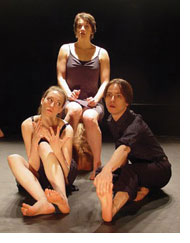 New Paradise Laboratories New Paradise Laboratories
Stupor
April 24
On April 24, the series showcases Philadelphia’s
New Paradise Laboratories in a performance of Whit
McLaughlin’s Stupor, inspired by Francisco Goya’s
Los Caprichos etchings. The company’s experimental “movement
theater” pieces are noted for “tremendous
physical energy, ironic awareness to burn and … playful
sexuality.” Each one attempts to slide between
the sheets of pop culture to better understand just
what’s going on under its covers.
AMP @ The Warhol
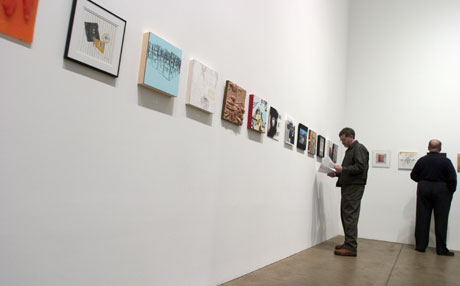
PHOTOS: TERRY CLARK
When Pittsburgh's non-profit Sprout Fund
decided to expand the successful month-long local music
showcase it sponsored in 2003 to include other artistic
genres, The Andy Warhol Museum got right on board as
a co-sponsor of the visual arts component. As part
of this year's AMP (Art, Music, Peformance) project,
The Warhol partnered with the Sprout Fund to present
a juried exhibition of more than 100 local artists;
on view throughout the month of February.  Submissions
to AMP were open to all artists from the Pittsburgh
region with the guideline that all works
had to be exactly 12"x 12" square. More
than 270 works were submitted for consideration—their
diversity reflecting the varied collection of the
region's artists. The Warhol's director, Thomas Sokolowski,
and John Smith, assistant director of collections
and
research, narrowed that number down to the 138 works
they considered to be the cream of the crop. The
majority of the works in the exhibition were for
sale. Submissions
to AMP were open to all artists from the Pittsburgh
region with the guideline that all works
had to be exactly 12"x 12" square. More
than 270 works were submitted for consideration—their
diversity reflecting the varied collection of the
region's artists. The Warhol's director, Thomas Sokolowski,
and John Smith, assistant director of collections
and
research, narrowed that number down to the 138 works
they considered to be the cream of the crop. The
majority of the works in the exhibition were for
sale.
The mission of the Sprout Fund and the
goal of the
AMP project was to expose local artists to new
audiences, and vice versa, in an effort to promote
and expand
Pittsburgh's growing arts scene.
As a companion
to the AMP exhibition, The Warhol also presented
the Flat File project, the acclaimed
traveling
component of the artist-run Pierogi 2000 gallery
in the Williamsburg section of Brooklyn, New
York. Pierogi
2000 founder, Joe Amrhein, was inspired to create
the File as a way of making the artwork of young
and emerging
artists available to a larger audience of potential
collectors. The version of the Flat File on view
at The Warhol showcased the two-dimensional work
of more
than 275 artists from around the world.
The unique
installation featured artworks hung on the gallery
wall that corresponded to numbered
drawers
in the File—allowing visitors to delve
into the file and leaf through a particular
artist's complete
portfolio. As was the case in the AMP exhibition,
each work of art in the Flat File was for sale
and reasonably
priced, making it possible for visitors to
The Warhol to purchase a drawing or print from
a
wide-range of
up-and-coming artists.
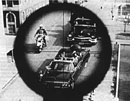 Film Series Closes JFK Film Series Closes JFK
Assassination
Exhibition
The assassination of President John F.
Kennedy has been examined in many forms, but one of
the most provocative has to be film. Because the medium
is so popular, people tend to be very aware of film-based
treatments that document, fictionalize, or selectively
reflect the event and its aftermath.
When The Warhol’s
Film and Video Department’s
Programmer Greg Pierce planned the series that accompanies
The Andy Warhol Museum exhibition, November 22, 1963:
Image, Memory, Myth, he paired popular films with
lesser-known productions to give viewers a closer
look at “how
much thought has gone into this incident in our history.” Some
films may not provide definitive insights on their
own, he says, but their impact grows when placed
on a double bill. Some also enhance understanding
of the
exhibition’s context, and vice versa.
For example,
The Warhol’s final program combines
The JFK Conspiracy: The Case of Jim Garrison, with
Oliver Stone’s controversial drama, JFK. The
former, done in 1967, is an hour-long NBC white paper
examining New Orleans District Attorney Jim Garrison’s
attempts to prove a conspiracy.
“You’ll see the real Garrison,
you’ll
hear him talk, you’ll see the real witnesses,” Pierce
says.
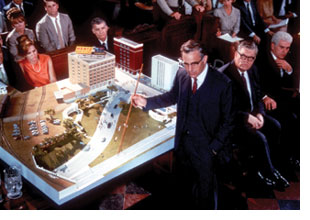 A
scene from JFK (1991), directed by Oliver Stone; Pictured;
Kevin Costner. A
scene from JFK (1991), directed by Oliver Stone; Pictured;
Kevin Costner.
Stone’s 1991 film, starring Kevin Costner,
stretches Garrison’s character, compresses
others, and fictionalizes the story to drive the
drama and prove
that the conspiracy angle is not farfetched.
Together, they leave viewers with much to contemplate,
and, as Pierce notes, show just how vast a
field of study and speculation Kennedy’s assassination
has wrought. The double-bill will be shown at 12:30
p.m., March 20 and 21. Winter Kills, the 1979 film starring several well-known
actors including Jeff Bridges, John Huston, Anthony
Perkins, and Elizabeth Taylor, will be shown at
3 p.m., March 13 and 14. Bridges plays the head of
a Kennedy-like family who investigates the assassination
of his brother, the president.
“
It deals with the paranoia and the conspiracy surrounding
the assassination,” as most of the series’ fiction
films do, Pierce says.
At 12:30 p.m., March 6 and 7, The Warhol will screen
the ABC-TV miniseries, The
Trial of Lee Harvey Oswald.
Another fiction piece, it considers what might
have happened if Oswald had gone on trial for Kennedy’s
killing instead of being shot by Jack Ruby.
All films
are free with admission. November 22, 1963: Image,
Memory, Myth will be on view through March
21.
Back to Contents |